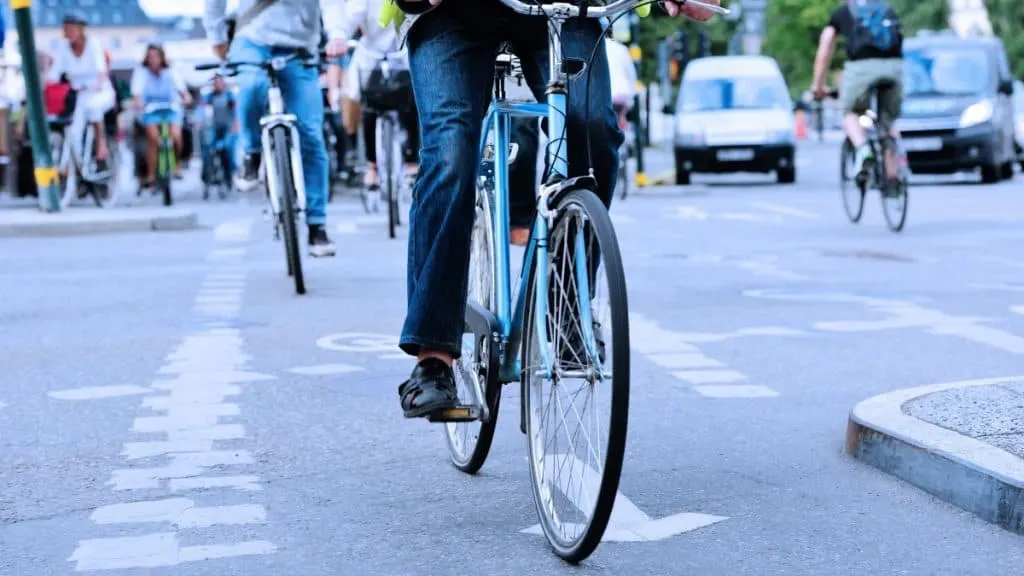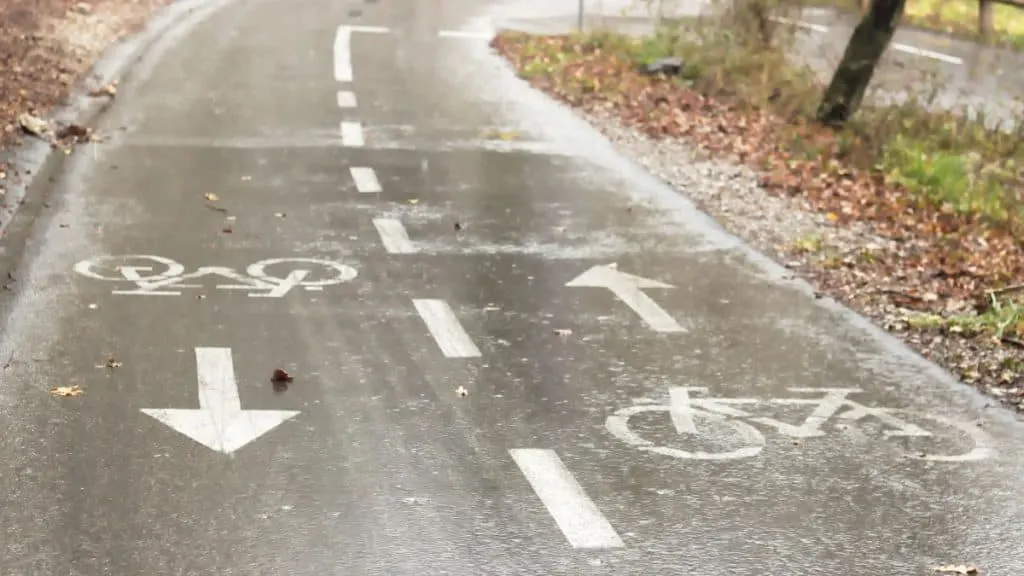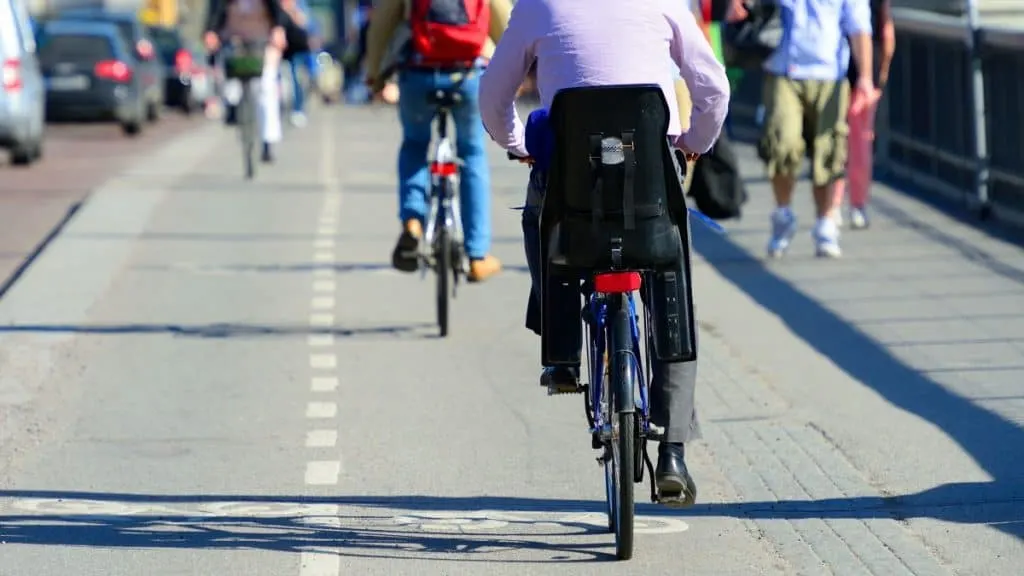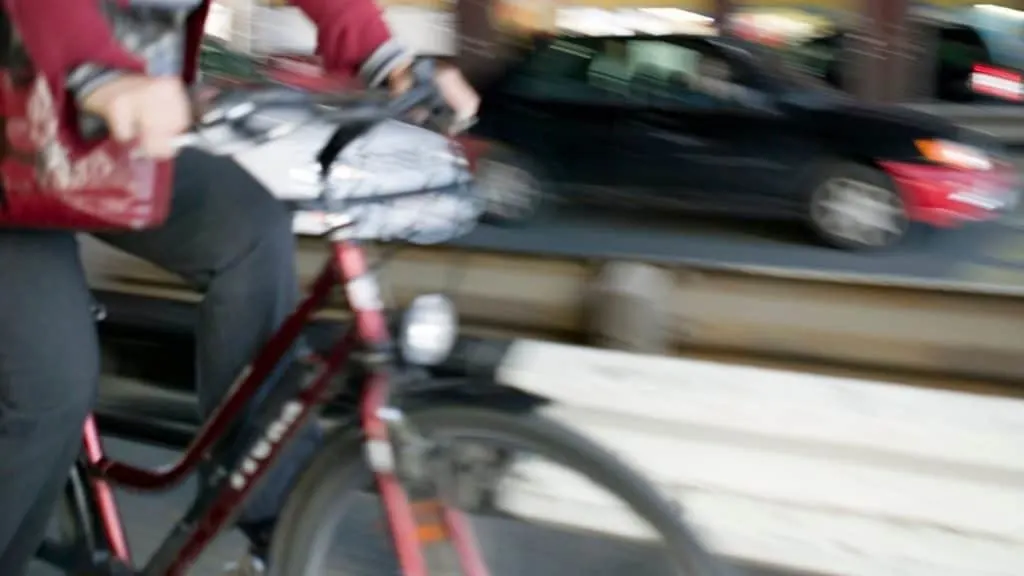
Especially as a beginner cyclist, it can be pretty scary biking alongside city traffic. And you might be wondering like I did if it’s safer to travel with or against the flow of traffic.
Cyclists should always travel with the flow of traffic. Although it is not necessarily mandated by law in some places, it is still highly recommended that you do so. Riding against the flow of traffic greatly increases the chance of traffic accidents and unexpected crashes.
So that’s the rule, but as a beginner, I always thought, “isn’t safer to cycle against the flow of traffic so that I can see what’s happening?!”
That was me a year ago. And many cyclists still believe, like I did, that riding against traffic is a reasonable decision; doing so allows them to be aware of and be able to react to oncoming traffic.
Why, then, would it be safe to ride with the flow of traffic? This article will explain why this rule is enforced and encouraged in a myriad of places.
It’s important to understand how it works so that you can be safer as a cyclist among traffic. But first, is it actually illegal? And if so, why?
Is it Illegal to Cycle Against the Traffic?
In most places around the world, it is certainly illegal to cycle against traffic. Not only does it pose great danger for you, the cyclist, but it also makes driving for others on the road much more difficult.
Let’s examine whether or not cycling against traffic is allowed in Canada, the United States of America, Australia and the United Kingdom.
- In Canada
- It is prohibited by law to cycle on the left side of the road, or in other words, against the flow of traffic since cars travel on the right side of the road.
- In Ontario, the law states that any vehicle, including non-motorized vehicles like the bicycle, travelling slower than the normal driving traffic speed should travel on the right-hand lane.
- If possible, cyclists should travel as close to the right edge of the road as possible to prevent the blocking of other cars and vehicles. The only exception to this law is when a cyclist must make a left-turn.
- The fine for violating this law is $105 CAD.
- In British Columbia, the law states that any person operating a bicycle on a roadway must ride as near as possible to the right side of the road.
- Additionally, it specifies that all cyclists that must take a left turn should ride the bicycle in the lane closest to the right side that permits a left turn.
- In the United States –
- It is also prohibited by law to cycle against the flow of traffic.
- In California, the law states, similarly, that cyclists must cycle as close to the right side of the road as possible.
- Unlike Canada, however, there are some more exceptions to this rule. Cyclists can pass other vehicles, avoid hazards and take the lane if the road is too narrow. However, none of these exceptions allows one to cycle against the flow of traffic.
- In New York, the law is even stricter. Cyclists are prohibited from travelling on any roadways in the case that a bicycle lane is present.
- Otherwise, cyclists should always travel near the right-hand edge of the roadway or a right-hand shoulder to prevent any inhibition of other vehicles on the road.
- Note that New York makes the same exceptions as the laws do in California.
- In the United Kingdom –
- Cyclists travelling on roads must follow the rules of the road i.e. ride with the flow of traffic.
- However, in some instances there are areas where the rules allow for cyclists to ride against the flow of traffic.
- There are laws also that prohibit interference with the flow of traffic.
- Furthermore, while there are plentiful designated bicycle lanes in the UK, cyclists are allowed to travel on the main roadway instead if they wish to do so.
- In Australia –
- It is prohibited by law to cycle on the right side of the road, or in other words, against the flow of traffic since cars travel on the left side of the road.
- Australian law states that all cyclists must keep to the left side of the road as much as possible.
- Like Canada and the United States, there are a few exceptions; cyclists are able to travel in the middle of the road when making a turn or when overtaking other vehicles. However, these conditions only occur with the flow of traffic.
- Unlike other countries, however, Australia permits cyclists to travel on sidewalks — or footpaths. However, if you choose to do so, you must, again, keep left and give the right of way to walking pedestrians. If you choose to ride on the road, however, you must use the bicycle lane when available.

In cases where it‘s allowed to ride either way, it is ultimately up to you to decide whether you would like to cycle with the flow of traffic or not. But it is important to understand why the rules exist so you can make an informed decision.
Why is it Unsafe to Ride Against Traffic?
Theoretically speaking, it should be safer to ride against the flow of traffic, since you have a better view of incoming traffic, right? If you ride against the flow of traffic, you can see everything in front of you and not expect anything to bump into you from behind.
Although this may seem like a benefit of cycling against traffic, there are a lot of reasons why it is very unsafe. Let’s take a look at 5 reasons why it would be unsafe…
#1: Drivers Cannot See Cyclists
Usually, cyclists don’t ride against the flow of traffic and drivers do not expect this either. And since drivers are not used to anyone going against traffic, they will pay less attention to them, making it harder for drivers to see cyclists who ride against traffic.
For example, in a country where people drive on the right side, if a driver is turning right, they may only look for oncoming traffic. They’ll turn into traffic without looking to the right since they expect that no one is approaching from that side.
Anyone who may be riding against traffic in this situation will be at very high risk for danger.
#2: The Cyclist has Less Time to React
Cyclists ride at around 15-25 km/h, depending on the road. On local roads, drivers drive around 50-70 km/h. This means a vehicle will pass a cyclist riding with traffic at 35-45 km/h.
This speed initially seems quite fast, but it actually still gives a reasonable amount of time for the driver to react to the cyclist. On the other hand, a vehicle will pass someone riding against traffic at 50-95 km/h!
There is still some time to react, but a far less than riding with traffic, making it relatively much more dangerous.
#3: Cyclists Cannot See Road or Traffic Signs
If someone is riding against the flow of traffic, then naturally, they cannot see road signs. Cyclists and vehicle drivers are expected to abide by the rules of the road, so if a cyclist cannot read a sign, they may be missing or breaking a specific rule.
For example, if a cyclist riding against traffic misses a stop sign, they could accidentally ride onto an intersection without noticing someone else is crossing the intersection.
Situations like these (missing road signs) would occur even more often at night since it makes it hard to even see signposts or what is written on them.
The bottom line is, it’s expected and easy for cyclists riding with traffic to follow the rules, and it puts you, and everyone else at a higher risk by riding against traffic.
#4: Headlights Are Too Bright
During the day, headlights won’t be much of a problem for anyone walking or cycling against traffic. However, during nighttime, staring into a stream of headlights while cycling would clearly become an issue.
The bright lights will most likely obscure the view or break your focus on the road ahead of you. Cyclists may accidentally find themselves in a different lane than they expected, even worse, a lane with an oncoming car.
There is a reason why there are headlights and taillights on each car; headlights are intended to be bright, while taillights are meant to be a signal for whoever is behind the vehicle.
Riding at night, it’s much harder to see, even with headlights and streetlights. And riding against the flow of traffic will cause more danger than is necessary for you and others.
#5: It’s Statistically Safer to Cycle with the Flow of Traffic
If you are still unsure or not convinced from what you’ve learned above, take a look at this table. The “Risk Ratio” compares how much riskier it is to ride against than ride with traffic.
The greater the number is than one, the more dangerous it is. So even if you disregard all of what we’ve talked about above, looking at things purely from a statistical point of view, it’s far safer to ride with the flow of traffic rather than against it.
Why Should I Cycle with the Flow of Traffic?
Other than the fact that it is required by law in some places and that it is significantly more dangerous to cycle against the traffic, why should you? Here are 5 advantages to cycling with the flow of traffic…
#1: You can Easily be Seen by Others on the Road
Riding with the flow of traffic allows you to ride predictably. In other words, other drivers will easily be able to spot you.
For example, cars that are turning out of intersections usually only look at oncoming traffic before they turn, rarely checking both sides. If you ride with the traffic, these drivers will easily be able to spot you before turning.
#2: It Ensures the Safety of Other Cyclists

Cycling against traffic creates dangerous situations for not only you but also other cyclists that ride with the flow of traffic.
When there are cyclists riding in opposite directions, there is rarely enough space for others to swerve to avoid collisions.
#3: It Doesn’t Interrupt the Flow of Traffic
When riding with the flow of traffic, cars can slow down or pass you if you travel at a slow speed. Although this may slow down traffic, it will not cause any large issues.
However, if you ride against the flow of traffic, cars must either stop or swerve into a dangerous position to avoid you or adapt to your slow pace.
#4: It is the law to Cycle with the Flow of Traffic
As mentioned earlier, many countries, states and provinces prohibit cyclists to travel in the opposite direction of traffic flow.
In the case of violation, you will be fined or face other consequences.
In the case that you get into any traffic accident with a motorized vehicle when riding against the flow of traffic, you will also be at fault.
#5: Physics Suggests you Should Ride with the Traffic
Say, for example, you are riding at 20km/hr when a vehicle collides with you from behind at a speed of 40km/hr.
On the other hand, if you collide with the same vehicle at 40km/hr in opposite directions, the consequences will be much deadlier.
While the former only results in an impact at 20km/hr, the latter creates an impact of up to 60km/hr. The harder the collision, the greater the damage.
QUICK TIP: If you’re new to cycling in traffic conditions, it can be quite scary to start cycling without being able to see what is behind you, but rest assured that with experience you’ll soon find that you feel a lot safer cycling this way.
Tips to Ensure your Safety when Cycling with the Flow of Traffic
Cycling alongside motorized vehicles can sometimes be dangerous, especially in crowded streets or during rush hour. After all, a traffic accident or a crash on a bicycle on a roadway usually results in injury or worse.
However, sharing the road with other vehicles is an inevitable part of life if you plan on utilizing your bicycle as your main form of transportation. Here are 9 tips for cycling safely with the flow of traffic…
Tip #1: Wear a Helmet
Although it is essential that all cyclists wear a helmet, it is especially important for those riding in traffic. While many places around the world only enforce helmet laws for young peoples, it is strongly recommended to all riders.
In the case of a crash, it greatly decreases the chance of permanent injury and greatly increases the chances of survival. Check out my article here for information on choosing the right bike helmet.
Tip #2: Wear Bright Clothing
This allows other vehicles or persons on the road to easily spot you, especially in dark or low-visibility conditions. This prevents traffic accidents caused by careless drivers or poor weather conditions.
Check out my Recommended Gear section for all of my favorite safety gear while cycling.
Tip #3: Obey the Law
As a cyclist, it is your duty to follow the law. Contrary to common belief, all the traffic laws that apply to motorized vehicles also apply in the same way to bicycles.
Be aware of and obey traffic signs and signals on the road, because as a cyclist, you are considered a road user just as much as other vehicles. Following signs and signals will let other road users understand you better too, and this will keep you safer.
Tip #4: Control your Speed
Do not ride too quickly, even when you are in a rush. Safety should be every cyclists number one priority. Ride at a safe and reasonable speed, giving yourself sufficient time to react to any sudden changes in the environment or circumstance.
Tip #5: Yield to Other Vehicles
Cyclists on the roadway should always yield to other vehicles. Because you will be the slowest party travelling on the roadway, you should allow other vehicles to pass and have the right of way. You do not want to interfere with the flow of traffic under any circumstance.
Tip #6: Use Bicycle Lights.
If you plan to ride at night or in low-visibility conditions, make sure that you have both bicycle lights and reflectors. (This is a great value set that’s available on Amazon).
Riding in the dark makes you invisible to other vehicles on the road, which can lead to fatal accidents and unwanted encounters. Note that this tip is not just a tip; some states and countries mandate bicycle lights by law.
Before embarking on your nighttime journey, be aware of what is required of you, a cyclist, by your government.
Tip #7: Keep a Safe Distance between You and Other Vehicles

In the case of sudden stops or turns, giving yourself distance will prevent any unfortunate collisions with other vehicles. If you live in an area that snows during winter, you should even allow yourself extra distance.
Many vehicles can skid in these icy conditions, which requires additional distance to arrive at a full stop.
Tip #8: Ride in Single File
While some places allow two cyclists to ride side-by-side, avoid this unless it is absolutely necessary. Riding side-by-side can slow down and interfere with the flow of traffic on busy roadways.
Tip #9: Keep your Hands on the Brake at All Times.
You should be able to brake at all times. Being able to stop quickly and efficiently is the key to keeping yourself safe in traffic, especially in the face of careless drivers.
Keep your fingers covering the brakes at all times when riding to ensure you are always able to stop quickly when needed.
In summary, all cyclists should travel with the flow of traffic. Not only is it required by law in many countries, since it protects everybody on the road, but it also makes it significantly safer for you, the cyclist.
After examining and considering both the benefits of travelling with the flow of traffic and the disadvantages of travelling against the flow of traffic, I hope you make the best, safest, and the most efficient decision for everybody.
